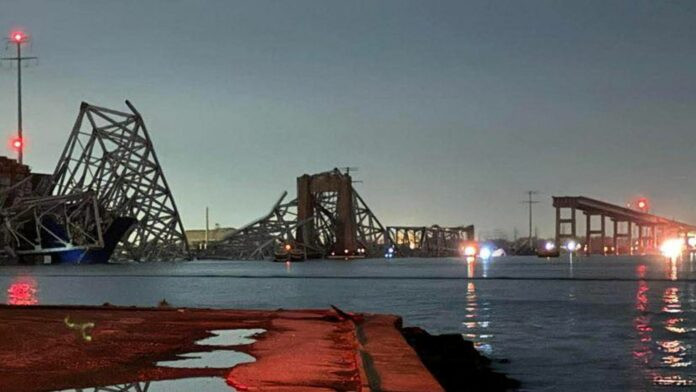

The collapse of the Baltimore bridge is a tragedy. But the impact on supply chains at a global or even North American level won’t be huge – and overhyping it could risk losing public trust and fanning the flames of inflation. Let’s avoid crying wolf.
US Secretary of Transportation Pete Buttigieg’s comment last week was a bit much: “This will be a major and protracted impact to supply chains.” I doubt it.
The collapse was shocking and the deaths of six construction workers a tragedy. Plus, the people of Baltimore will remember it with sadness forever. But the impact on supply chains at a global or even North American level won’t be huge.
What happened
The exact failure of the container ship Dali is still unknown, but video images show a loaded vessel losing its lights, and presumably power, briefly gushing black smoke from its funnels, getting its lights back, and then hitting the main bridge support. The bridge collapsed onto the bow of the ship in less than ten seconds.
What it means for supply chain: ports
The Port of Baltimore is closed, with 40+ vessels stuck inside the fallen bridge, and all inbound vessels being rerouted. It is not known how long clearing the passage will take.
In terms of volume, Baltimore is not a vital US port. It ranks seventeenth in total tonnage, tenth in dry bulk tonnage, and fifteenth in TEU volume. Alternative east coast ports include New York, Savannah, and Virginia, all of which are larger.
Baltimore is, however, a key port for roll-on/roll-off shipments, including cars, trucks, and farm equipment. This will create problems for manufacturers, like Deere and Caterpillar, moving product overseas. These are finished goods, though, which means ripple effects seen in Europe when parts held up by Red Sea attacks forced some stoppages at Tesla and Volvo assembly plants won’t be an issue this time. Also, auto dealerships in the eastern US may wait longer for imported vehicles to arrive, but again, these are finished goods en route to lots full of inventory.
From this perspective, the impact will be minor compared to the post-Covid crisis that put supply chains on our collective radar.
What it means for supply chain: road
The accident also knocks out a major interstate highway for years, if not forever. That sounds terrible, but the bridge only carries 11 million vehicles per year compared to parallel north-south harbor tunnel routes, which, combined, carry almost 72 million vehicles each year. It is true that hazmat transport is prohibited in these tunnels, but the western loop of the Baltimore beltway is an option, adding about 15 miles to the Patapsco River crossing. Again, the impact on supply chains should be relatively minor.
READ: Baltimore Bridge collision was preventable
What it means for supply chain: infrastructure
As for the argument that our infrastructure is “crumbling” and supply chains are therefore “fragile,” the Key Bridge collapse is more symbolic than symptomatic. It was inspected in 2023, passing over a dozen specific metrics of structural integrity tests according to the US DOT’s National Bridge Elements Health Index. But it should be no surprise to anyone who saw the footage that the bridge couldn’t handle a direct hit from a container ship – our supply chain infrastructure does need more investment, especially our outdated seaports, but the collapse of this bridge is not proof of that idea.
The good news: resilience and vigilance are working
Celebrated, but disproportionately to the initial hysteria about “snarled supply chains,” was the fact that the ship signaled distress and, within minutes, police had stopped traffic in both directions. Plus, technology-heavy logistics firms like project44 and Flexport, which track and help manage global shipping for big companies, are already rerouting shipments that were headed to Baltimore.
Supply chain managers are currently handling problems in more important transportation choke points, including the Suez Canal and Panama Canal. More worrying still is the threat of a strike at all US East Coast ports.
Transportation and logistics leaders have significantly improved resilience since the Covid crisis, meaning that most are already well into contingency plans in response to thisdisruption.
The bad news: news
Buttigieg isn’t crazy to warn of supply chain impacts arising from the Baltimore bridge tragedy, and televised news clearly can’t resist featuring the story. But the urge to overhype the supply chain angle risks losing public trust and fanning the flames of inflation.
Let’s not cry wolf.










